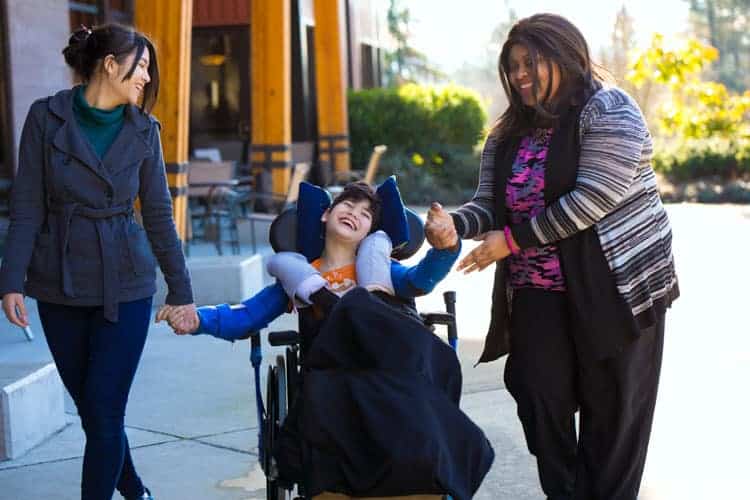As far as vacation destinations go, Walt Disney World is very accessible for children with disabilities. From special passes to low-key rest areas, Disney World has put significant time and effort into improving the Disney experience for kids with cognitive disabilities, physical disabilities, and Autism Spectrum Disorder (ASD).
If you’ll be experiencing Disney with a special needs child, the following information can help you prepare. Learn how to navigate a new, unfamiliar, exciting, and busy place while still managing the daily wants, needs, and expectations of each person in your party. As with any large theme park, it is recommended to review any updates to the Know Before You Go information just to be sure.
Please note: the following information is geared towards families visiting Disney World with a special needs child. But much of the information provided would also apply to the Disney World experience of adults with cognitive disabilities and people of all ages with physical disabilities.
Inspired by quotes from Disney movies, the following tips will help you make the most of your Disney World magic!
“No one saying do this, no one saying be there”—Build some unstructured time into your day.

Structure your days, so your kiddo doesn’t get overstimulated and doesn’t feel rushed or pushed to do things. For example, spend some time wandering around when you first arrive at your hotel or vacation rental to become familiar with your surroundings and decompress a bit. Exploring, getting the lay of the land, and locating the bathrooms will help everyone feel more comfortable. When visiting theme parks, budget some time just to sit and relax or wander.
It is worth considering staying on Disney property within the Walt Disney World Resort. It may be one of the more expensive options, but the benefit of being that much closer to your room or the resort pool may outweigh the additional cost for families with children who have special needs. The Disney Resort Hotels offer a variety of services and accessible accommodations for those staying in the resorts – including wheelchair-accessible rooms and accessible paths of travel.
Rest and regulation can happen back in the comforts of your hotel room, and then everyone could head back to the park. Families of children with physical disabilities or children in wheelchairs should also consider this for proximity to the attractions. It will help cut down on the travel time to and from the park.
“Be our guest”—Make your dining plans and reservations in advance.

Disney World makes it easy to find and research the best food options for your family. You can filter dining options by cuisine and service type and make reservations online.
If your little one has special dietary needs, you’ll find that many dining facilities in the park can accommodate most allergies, intolerances, and other dietary restrictions. And don’t forget, guests with food allergies or intolerances can bring food into the parks. For more info about Disney World food options for allergies, check out AllergyEats Disney World.
Outside of dining plans and reservations, Walt Disney World Resort allows you to make reservations for #allthethings. Extensive planning takes the spontaneity out of vacations, but for families with special needs, it is most often what makes the vacation. Popular attractions can be reserved in advance for non-peak times or during the cooler portions of the day. Theater performances and shows can also be scheduled in advance, allowing rest to be built into your day.
Related Articles:
- Strollers at Disney World: What’s Allowed & What’s Not
- Visiting Orlando: Orlando Travel Guide For Families
- BabyQuip Baby Gear Rentals: How to Get Started
“Remember, you’re the one that can fill the world with sunshine.”—Prepare your little one for all the wonders of Disney World!

With a smile and a song (and little help from the Internet), you can prepare for your Disney vacation by watching videos online. There are dozens of official Disney videos to help you see what the rides and entertainment look like. A quick search on YouTube also reveals hundreds of videos taken by visitors. Another way to help your little one prepare—talk to them about what they can expect. Where will they sleep? What can they expect for breakfast, lunch, and dinner? What will the crowds and noise be like? If lines and waiting are something your kiddo struggles with, practice ahead of time, pack headphones, earplugs, sensory toys, or a favorite device into your day bag.
Making a couple of reservations in advance will also allow you to prepare a ‘rough guide’ of your day. Knowing what attraction will come first, followed by what type of meal, may provide the structure needed to keep the day running smoothly. It will also allow you to thoroughly review the ins and outs of each planned ride.
Walt Disney World has created several guides for guests with disabilities (included below). One of these outstanding guides highlights attraction details for all of the attractions in each theme park. Think of loud noises, elements of surprise, type of restraint used, smells, and lighting effects. For example, Buzz Lightyear’s Space Ranger Spin has lighting effects and loud noises. And the Rock ‘n’ Roller Coaster starring Aerosmith is fast with sharp turns, sudden drops, and loops.
“Wherever they go, and whatever happens to them on the way, in their enchanted place on top of the forest, a little bear will always be waiting.”—Skip the ticketing line.

Winnie the Pooh might be waiting around, but you don’t have to—buy Disney World tickets online. There will still be lines, but purchase your tickets ahead of time, and you can saunter on past the ticketing line. In the park, you can use the My Disney Experience Mobile App to check wait times at specific attractions.
As part of Disney Park’s unwavering commitment to providing a welcoming and inclusive environment for guests, WDW theme parks offer Disability Access Service (DAS). This program is meant to assist guests who have difficulty tolerating extended wait times in a conventional queue due to a cognitive or physical disability. While DAS doesn’t provide immediate access to experiences, it allows guests to request a return time for an experience that is comparable to the standby wait – this way, the family can enjoy other experiences instead of physically waiting in line. Eligible guests can pre-register for DAS Advance virtually with a cast member virtually – the cast member will help you book up to two return windows for select experiences.
Although it is at the discretion of an individual cast member, strollers (personal strollers and rented strollers) can be designated as wheelchairs for guests. These strollers must adhere to all the Walt Disney World stroller rules. And the wheelchair designation is not given until the of park entry (WDW Made Easy).
“Look for the bare necessities, the simple bare necessities.”—Enjoy some downtime at one of the many Rest Areas located throughout the park.
Naps are a bare necessity, right? We think so! There are Rest Areas located throughout the park where you can rest and relax. These are especially useful if your kiddo is highly sensitive and needs a place to unwind. If your little prince or princess needs some beauty sleep, consider heading over to one of the nearby Disney World resorts. You can soak up the air-conditioning in a lobby or find a quiet corner. For more expert tips on where to nap, check out Disney Diva and TripSavvy.
Inside the Walt Disney World Cognitive Guide, there is a page dedicated to examples of ‘little less busy’ quiet places to take a break within each of the Disney Theme Parks for your family member or children with disabilities. For example, the guide recommends the Walkway surrounding Echo Lake in Hollywood Studios.
Walt Disney World Made Easy has great information regarding breaks and rests within the theme parks. Many first aid stations within the parks have separate semi-private areas (although not sound-proof) for respite, along with other resources that children with disabilities may need; larger changing tables, IV poles for medication delivery, etc. Full-service restaurants at off-peak times are another great option – the family can rest in a cool and (relatively) quiet atmosphere.
“Venture outside your comfort zone. The rewards are worth it.” – Or don’t. There are many resources to help you decide.
The internet is your friend when it comes to learning all about the various rides at the parks within Disney. Whether you’re looking to ride It’s a Small World in Magic Kingdom or Kilimanjaro Safaris in Animal Kingdom; you can learn all about their ups and downs beforehand.
There are so many resources online to help your family understand the conditions of the rides in all of the Disney Theme Parks. In addition to the WDW Attraction Details Matrix, Walt Disney World Made Easy for Everyone has a ton of great articles about all things Disney, including notes and cautions about the most popular rides. There are lists of gentle and non-spinning rides broken down in each theme park, as well as articles extensively detailing the most popular attractions and rides.
More Disney resources:
- The Disability Access Service (DAS) —is an excellent program for guests with a disability that prevents them from waiting in line.
- The Rider Switch program allows two adults to take turns on a ride while the other waits with the non-riding guest(s).
- Official Guides for Guests with Disabilities include info about accessible transportation options, where companion restrooms are located, and more. Guides are available for the following theme parks:
- Planning a Trip to Walt Disney World – A Resource for Guests with Cognitive Disabilities including Autism Spectrum Disorder (ASD)
- Walt Disney World Attraction Details Matrix for Guests with Cognitive Disabilities
- Magic Kingdom (PDF)
- Epcot (PDF)
- Disney’s Hollywood Studios (PDF)
- Disney’s Animal Kingdom (PDF)
- The My Disney Experience Mobile App allows users to check wait times at popular attractions. You can also order food from some quick-service restaurants, navigate the park, and more! Available on the App Store and Google Play.
Third-party resources we recommend:
- Autism At The Parks has tons of useful info for guests who are going to visit Orlando’s theme parks with a family member with autism or other developmental disability.
- BabyQuip offers baby and toddler gear rentals of all kinds that make navigating Disney World easier. Nine Quality Providers are on standby to deliver gear right to you to make your trip less stressful.
- Walt Disney World Made Easy for Everyone has more information than you can imagine about the attractions and rides within each of the theme parks, as well as some of the best accessibility options, including wheelchair and ECV rentals.

Kathy is a freelance writer, an Independent Quality Provider with BabyQuip and the mother of a very active one-year-old boy. When she’s not changing diapers, developing engaging content for clients, or helping families travel with little ones, she enjoys reading, gardening, yoga, and naps.



Looking forward to reading more. Great article post. Much thanks again.
wonderful issues altogether, you simply won a new reader.
I think this is a real great blog. So glad ot see you including families with spcial needs.
Highly energetic article, I loved that a lot. Will there be a part 2?
I couldn’t refrain from commenting. Well written!
Great content, not often thought of.
Do you have any video of that? I’d love to find out some additional information.